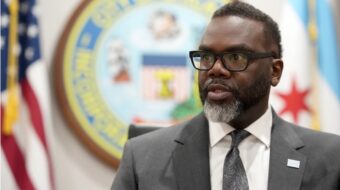On Wednesday, October 12, thousands of students, labor leaders, and community activits tuned in to the AFL-CIO’s “America Wants to Work” National Teach-In. The teach-In was live-streamed from the University of California Washington Center in Washington, D.C. Hundreds of university campuses organized local events to watch the Teach-In in a classroom setting. An articulate panel of student leaders, representing the broad and inspiring spectrum of student-labor alliances in the country, led the meeting.
The hosts of the event were Tiffany Loftin from the United States Student Association, and Lenore Palladino from MoveOn.Org. The panelists included representatives from United Students Against Sweatshops, the Student Labor Action Project, the campus group which led the student walk-out at the University of Madison Wisconsin, Students for the Dream Act, and the leader of a 700 student walkout at Rutgers University which led to the lowest tuition increase at Rutgers in decades.
“It’s a very special occasion that we have all of these powerful student leaders in one room,” said Palladino in her opening remarks. “We are going to get to hear some of their victory stories.”
After the opening remarks, Robert Reich, former labor secretary under the Clinton Administration, provided an overview of the current economic situation. Reich confirmed that “we are in the worst economy since the Great Depression, with 25 million Americans who are unemployed.” However, he also emphasized one aspect of this economy that differs from that of the 1930’s, which is the unprecedented disparity between corporate profit and wages. “The top 1%,” he argued, “has collected more than 20% of all national income, and 35% of the total wealth of the country.” Reich stated that labor unions are a “big part of the answer”, because workers need bargaining power to win human needs such as health care, decent wages, and education.
Terasia Bradford from Ohio State University explained why, for her, the student struggle and workers’ struggles are inseparable. “I’m the daughter of a single parent, working class, and a woman of color. We are the most affected by the financial practices in this economy.” A native of Dayton, Ohio, Bradford has been a leader in the organizing drive at Ohio State to unionize the workers at the University’s football stadium. “Students have a lot of power. Because we pay tuition, we can affect how and where our money is spent.” Bradford also highlighted the fact that the president of Ohio State is the highest paid president of any public university, while the stadium workers make poverty wages with no health care. “He can afford to take a pay cut, so workers can have what they need.”
Following Bradford, the rest of the student panelists shared experiences of fighting for workers and students rights on their respective campuses. Each speaker was confident and articulate. Towards the end of the teach-In, Frances Fox Piven, sociology professor at the City University of New York, applauded the students and reminded those present that, often times, student uprisings lead to broad sweeping social change.
To watch this teach-In was to get the impression that today, labor activism is far more than just another recreational student activity on U.S. college campuses. The sophistication of the campaigns that were described instead indicate a renewed, broad-based, labor consciousness amongst students and young people. These student leaders obviously see their own future economic stability, and the future of higher education, as depending on the strength of the labor movement.
To watch the teach-in yourself, and to get involved in the AFL-CIO’s “America Wants to Work” campaign click here.










